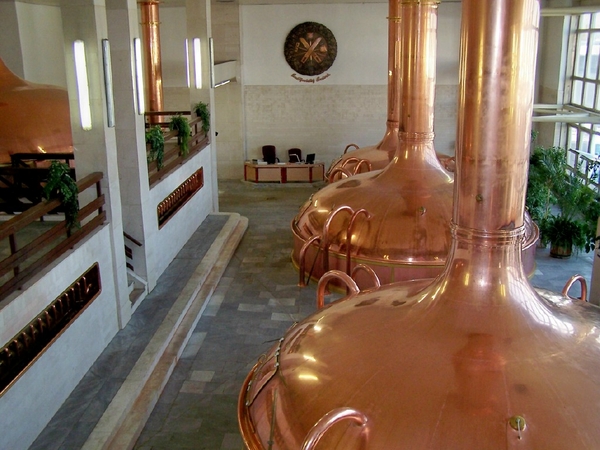All lagers the same? Adjust your tastebuds
Added: Thursday, August 14th 2014

Lager drinkers struggle to distinguish one brand from another, according to a blind tasting conducted in Stockholm involving 140 volunteers aged 21 to 70. The tests were carried out by Johan Almenberg and his wife Anna Dreber of the Stockholm School of Economics, and Robin Goldstein, author of The Beer Trials and a forthcoming book Blind Taste.
The tasting is a curious affair. For a start, you have to ask what credentials economists Almenberg and Dreber have to conduct such a trial and why they chose just three European beers: Czech Budweiser Budvar (brewhouse pictured above), Heineken and Stella Artois, and lump the three beers together as “big name brands”.
The absurdity of this choice is underscored by Goldstein’s comment that “the products are interchangeable. The industry has perfected pale lager beer, which is my favourite style of beer.” This suggests he has a serious malfunction of the taste buds.
He compounds the problem by adding that lager brewers have “a good product, a good manufacturing method and it can be sold at a good price. So if you’re in a bar and they don’t have the lager you usually drink, have a different one. They will pretty much taste the same.”
It’s ill-researched nonsense. You might expect the economists involved in this exercise to be aware of differences in the brewing industry and to be able to distinguish between mass global brands such as Heineken and Stella and the much smaller Budvar. The two big brands are brewed in a variety of locations while Budvar is brewed only at source in the Czech Republic.
And they are astonishingly ignorant of the manner in which global lager brands are made, in sharp distinction to the painstaking craftsmanship of traditional brewers such as Budvar.
What Goldstein calls “a good manufacturing method” is now ubiquitous among the likes of AB-InBev – which owns both Stella and American Budweiser – Carlsberg, Coors and Heineken. All the beers have a 21-day production cycle, from mashing the grain, boiling with hops, fermentation and packaging. It’s a system that flies in the face of the very meaning of “lager” – storage.
A true lager beer is stored, aged and conditioned for several months. But that is anathema to the accountants that run the global brewers. Their main aim in life is pushing beer out as fast as possible in order to maximise sales.
In sharp contrast, Budvar is aged for 90 days. It’s possible to tour the lager cellars at the brewery and taste the beer at one, two and three months to see how it develops over that long period, ending with a rich malt and vanilla aroma and palate with a delicate underpinning Czech Saaz hops.
The “experts” are blithely unaware of the crucial difference between mass produced global near-lagers and those from genuine, traditional breweries. And the narrow choice of beers in the tasting is curious. Why did they not include the other great Czech beer, Pilsner Urquell? The name, after all, does mean “Original Pilsner”, the first golden lager ever brewed. It’s a radically different beer to Budvar and emphasises the range of beer styles available in the Czech Republic.
While Budvar has a soft, creamy quality and is not aggressively hopped, Pilsner Urquell has a far greater hop character. With around 44 units of bitterness – twice as many as Budvar’s – it’s one of the bitterest lager beers available and its absence from the Stockholm tasting is bizarre.
But everything about the event is bizarre. Not only do lager beers not all taste the same but the sales of global brands are in sharp decline in their traditional western markets and are being challenged by new-wave lager beers from smaller craft breweries. In Britain, for example, Freedom Lager from Staffordshire has recorded remarkable growth in recent years while the WEST Bavarian beer hall and brewery in Glasgow is so successful that it’s planning a similar outlet in Edinburgh.
And how do the Stockholm people possibly explain the absence of some of the great German lager beers? There are enormous variations in character between the assertively bitter beers of the north – Jever Pilsener in particular – and the softer beers from Munich and Bavaria.
If anyone thinks all lagers taste the same, they should make a tour of the Czech Republic and Germany and revise their opinions.






